Simple Fruit Salad is fresh fruit chopped and dressed with citrus juice and honey. Choose your favorite seasonal fruit.
It’s hard to define and recognize a cuisine in today’s mobile society. People move about and take with them dishes from one cuisine and mesh them into another. The lines have blurred. Cajun and Creole are prime examples of this. The distinction between the two was pronounced at one time. Now, the differences are barely recognizable..
Southern food is undergoing a bit of an identity crisis. It’s not that Southern food can’t figure out who it is but rather that some folks have confused authentic Southern food with modern adaptations that include convenience foods which weren’t available to early day Southern cooks such as processed cheese (spread and block versions), non-dairy whipped topping (tub and aerosolized can versions), commercially prepared cream soups, packaged dry soups and cake mixes. The ever-increasing reliance upon these convenience items in Southern kitchens has led some folks, who regards themselves as culinary authorities, to describe Southern cuisine as lazy, “dump and stir” and undignified. People who only see my native cuisine through that prism are uniformed. Southern food often falls prey to culinary elitism. I think its honor and dignity is worth defending.
Southern kitchens are not immune to the” fast past, always running behind, trying to be in three places at once” lifestyle. Rulers of the Kitchen Kingdom must sometimes rely on quick-fix meals and convenience items to lessen the time from stove to table. The use of convenience items may be the difference between gathering a family around the kitchen table and everyone going in a separate direction and not sharing a meal. Some of those items have made their way to my kitchen. They have a place in our world.
Because the South was an agrarian society, authentic Southern cuisine focused on lots of fresh fruits and vegetables. Meals would consist of large bowls of steaming seasonal vegetables seasoned with butter, bits of smoked meats or meat drippings, breads such as biscuit or cornbread and fruit that was preserved or cooked into pies, cobblers or cakes. There’s no denying the Southern sweet tooth and the dessert was considered part of the meal. If fruit wasn’t available, a pound cake would serve as the sweet portion of the meal.
Despite its status as a Southern icon, Fried Chicken wasn’t an everyday occurrence. Chickens were prized for their eggs. Once a hen had become too old to produce eggs, you could expect she would be stewed in a large pot with either rice or dumplings added to stretch out the meal. Fried Chicken was reserved for a very special occasion because the chickens small and tender enough to fry were still in their egg laying prime.
Beef wasn’t a mainstay of the Southern diet. Cows were kept for milk which could be turned into butter, cheese and buttermilk as well as supplying sweet milk for drinking and cooking.
Pigs were a more practical food source. They required much less room than cows, took less time to mature and very little was wasted once butchered. “Everything but the squeal” would be used. The meat was for breakfast food and seasoning. Fat was rendered for cooking. Prior to refrigeration, very little of the pork would be eaten fresh. Aside from the hams, most of it was ground up for sausage meat. Hams and sausages would be cured and smoked to increase their shelf life.
Occasionally, wild game might provide a protein source. Small animals, such as rabbit and squirrel, were cut in pieces and cooked in gravy to stretch the meal.
Rivers and lakes would offer up fish to lucky fishermen. Residents of coastal areas might enjoy shrimp and oysters.
Rustic Southern cuisine was unpretentious, seasonal, flavorful and dependent on the bounty gathered by the hunters and farmers. Much of the South was poverty-stricken and the citizens raked and scraped together food the best way they could to feed their families and themselves. They relied on their survival skills and practical approach to living in order to get by. Cooking lessons, recipes and tips were passed down generation to generation. What food they had was shared with family, neighbors and strangers. Even during lean times when food was scarce, they gave thanks for every bite they put in their mouth.
The simple nature of rustic Southern food mirrored the simple life led by the people of the region. Rich sauces and complicated dishes with romantic names were simply not consistent with the lifestyle. By some, this simplicity has been interpreted as being undignified. Brothers and sisters, if dealing with your circumstances to the best of your ability using the only resources available to you while maintaining a grateful heart is undignified, then dignity is highly over rated.
For another great fruit salad and simple and easy, try Grape Salad recipe . If you’ve got extra blueberries, try combining them with watermelon for Blueberry Watermelon Salad .
Y’all come see us.
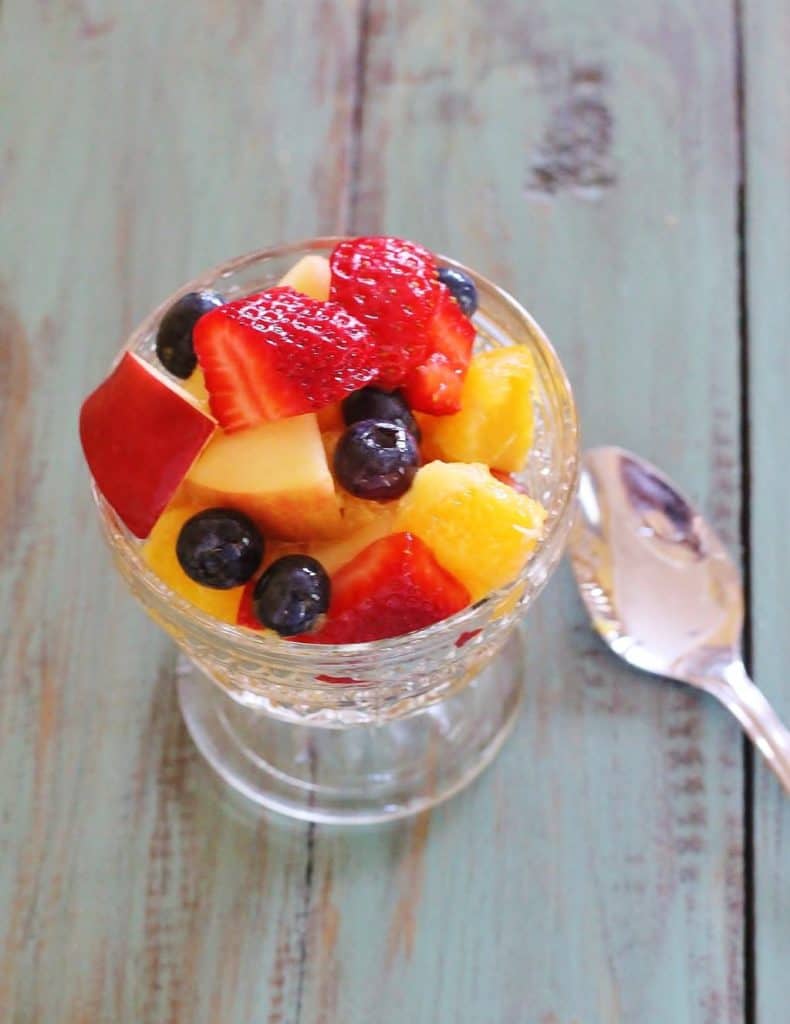
The fruit ingredients will likely change each time you make this salad. Choose the best fruit you can find.
Simple Fruit Salad
In the eyes of my mother, a celebration at our house wouldn’t be complete without a good fruit salad. You don’t need sugar or heavy cream if you use the best seasonal fruit and the best honey you can find. The ingredients will necessarily change according to availability. The dignity of this fine dish is in its simplicity.
3 oranges, divided (I have oranges growing in my yard and I’ll use what ever is ready to be picked. The oranges I’ve used today are Hamlins)
1 tablespoon honey(more or less depending on the sweetness of the fruit, I prefer Tupelo honey)
1 quart strawberries
1 large bunch red seedless grapes
2 Gala apples (or substitute your favorite eating apple)
2 bananas
optional: grated coconut and chopped pecans
Juice one orange and mix with honey. Set aside.
Peel and chop the remaining two oranges. Add to large bowl.
Wash, hull and chop strawberries. Add to oranges.
Wash and halve grapes. Add to bowl. Be sure to use seedless grapes.
Wash apples. I peel one and leave the peeling on the other for added texture, color and flavor. Chop and add to bowl.
Peel and slice bananas. Add to bowl. Slicing is better than chopping. The more surface that’s exposed, the quicker they will turn brown.
Pour orange juice and honey over fruit. My favorite honey is Tupelo. Shown below are two outstanding brands.
The acid in the orange juice will help keep the bananas and apples from turning brown. Gently stir to make sure all the fruit is coated. Adding coconut and chopped nuts (I prefer puh-kahns) is a nice addition. I left both of those out because I made this dish to take to a gathering and so many people have tree nut allergies.
Chill well before serving. Isn’t it simply beautiful?
Simple Fruit Salad
Ingredients
- In the eyes of my mother a celebration at our house wouldn’t be complete without a good fruit salad. You don’t need sugar or heavy cream if you use the best seasonal fruit and the best honey you can find. The ingredients will necessarily change according to availability. The dignity of this fine dish is in its simplicity.
- 3 oranges divided (I have oranges growing in my yard and I’ll use what ever is ready to be picked. The oranges I’ve used today are Hamlins)
- 1 tablespoon honey more or less depending on the sweetness of the fruit, I prefer Tupelo honey
- 1 quart strawberries
- 1 large bunch red seedless grapes
- 2 Gala apples or substitute your favorite eating apple
- 2 bananas
- optional: grated coconut and chopped pecans
Instructions
- Juice one orange and mix with honey. Set aside.
- Peel and chop the remaining two oranges. Add to large bowl.
- Wash, hull and chop strawberries. Add to oranges.
- Wash and halve grapes. Add to bowl. Be sure to use seedless grapes.
- Wash apples. I peel one and leave the peeling on the other for added texture, color and flavor. Chop and add to bowl.
- Peel and slice bananas. Add to bowl. Slicing is better than chopping. The more surface that’s exposed, the quicker they will turn brown.
- Pour orange juice and honey over fruit.
- The acid in the orange juice will help keep the bananas and apples from turning brown. Gently stir to make sure all the fruit is coated. Adding coconut and chopped nuts (I prefer puh-kahns) is a nice addition.
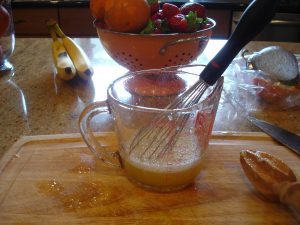
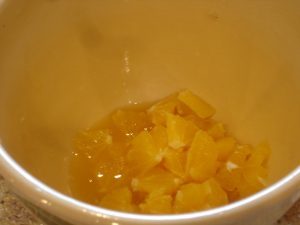
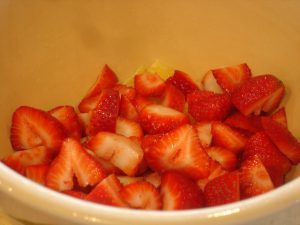
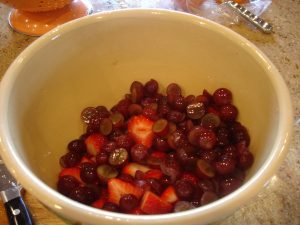
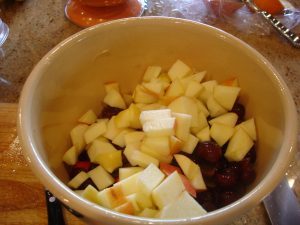
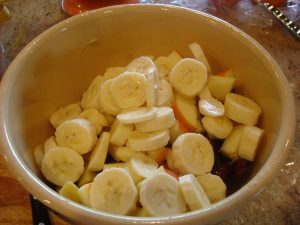
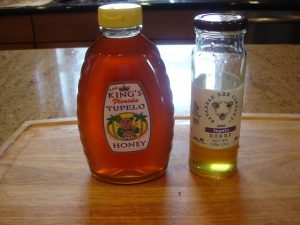
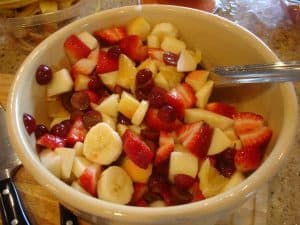
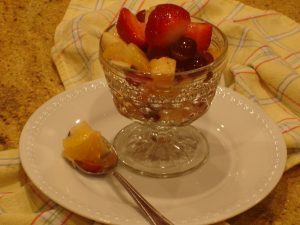
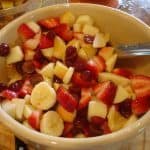

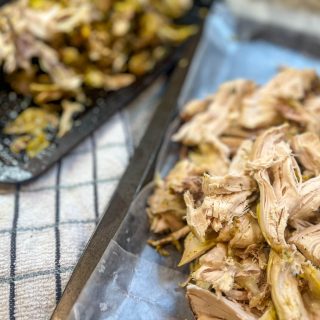
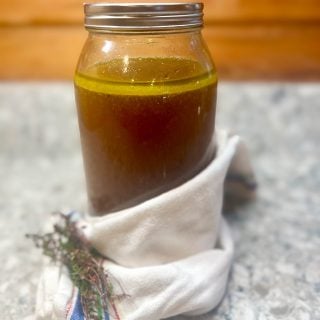
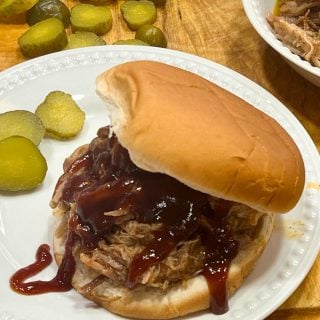
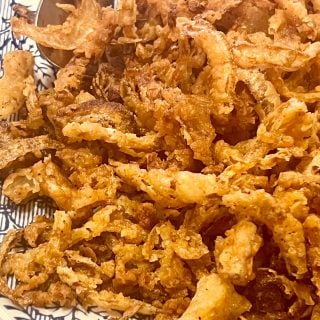
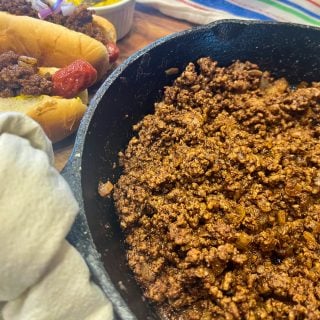
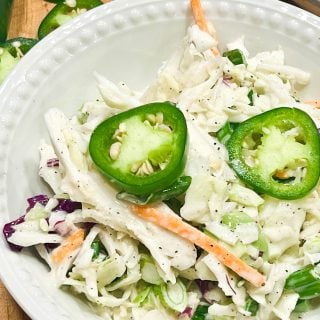

Cellest says
Love the way you show step by step what to do.Also the little history about dish. New fan to your site
Jackie Garvin says
Thank you, Cellest. Welcome to Syrup and Biscuits! 🙂